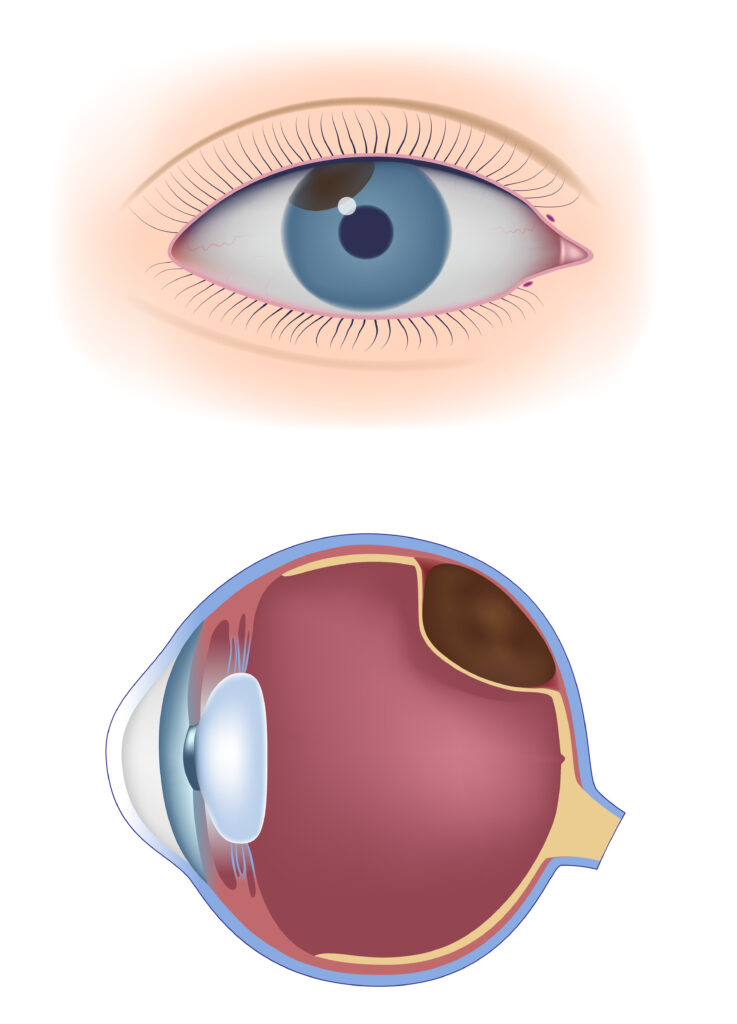Choroidal Nevus and Uveal Melanoma
Choroidal Nevus and Uveal Melanoma
Choroidal nevi are like harmless freckles or moles that can appear at the back of your eye. They are quite common and usually don’t cause any serious vision problems. On the other hand, uveal melanoma is a rare type of eye cancer that affects the vascular layer of the eye called the uvea.
Unlike the harmless nevi, uveal melanoma is malignant and needs immediate medical attention. It’s important to distinguish between these two conditions because while choroidal nevi are generally harmless, uveal melanoma requires prompt treatment due to its cancerous nature.

Choroidal Nevi
Causes
The exact cause of choroidal nevi is not fully understood. However, some factors may contribute to their development. These include exposure to sunlight, having fair skin, light-colored eyes, and a family history of nevi or eye cancer.
Symptoms
In most cases, choroidal nevi do not cause any symptoms and are often found by chance during a routine eye exam. However, larger nevi located near the center of the retina (the part of the eye responsible for clear vision) can sometimes cause changes in vision or distortion.
Diagnosing
To diagnose choroidal nevi, an eye care professional will perform a thorough eye examination. This may include tests such as checking visual acuity (sharpness of vision), dilating the pupils to examine the back of the eye, taking photographs of the retina, using a special imaging technique called optical coherence tomography (OCT), or using ultrasound to create images of the eye.
Monitoring and Treatment
Most choroidal nevi do not require treatment, especially if they are small and not causing vision problems. Regular monitoring is usually recommended to check for any changes in size or appearance. If there are any concerning signs or if the nevus is growing, further tests or referral to a specialist may be necessary to rule out the possibility of cancer.
Uveal Melanoma
Uveal melanoma is a rare form of eye cancer that affects the uvea, the vascular layer of the eye. Unlike choroidal nevi, uveal melanoma is malignant and requires immediate medical attention.


Causes and Risk Factors
The exact cause of uveal melanoma is not known, but certain factors may increase the risk. These factors include fair skin, light-colored eyes, older age, and a family history of uveal melanoma.
Symptoms of Uveal Melanoma
In the early stages, uveal melanoma may not cause noticeable symptoms. As the tumor grows, it can lead to blurred or distorted vision, dark spots or streaks on the colored part of the eye (iris), floaters (spots or lines in the vision), loss of side vision, or changes in the size or shape of the pupil.
Diagnosis and Treatment
Early detection is crucial for managing uveal melanoma effectively. Diagnosis involves a thorough eye examination, which may include dilating the pupils, using special dyes to evaluate blood flow in the eye, and ultrasound imaging to assess the tumor’s characteristics.
Treatment options for uveal melanoma depend on factors such as the size and location of the tumor, as well as the overall health of the individual. They may include surgery to remove the tumor, radiation therapy, or other targeted therapies.
It’s important to remember that while choroidal nevi are generally benign and uveal melanoma is rare, any changes or concerns related to the eyes should be evaluated by an eye care professional to ensure proper diagnosis and treatment. Regular eye exams can help detect these conditions early, increasing the chances of successful management and preserving vision.
